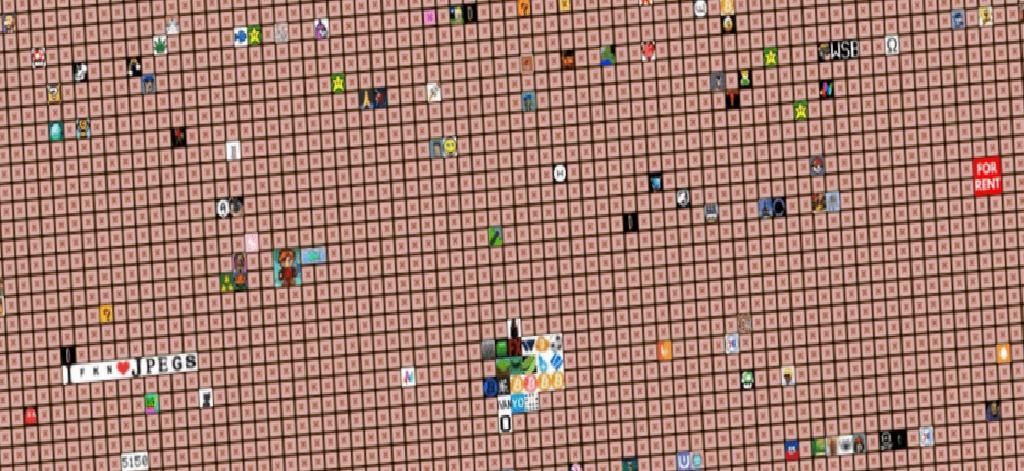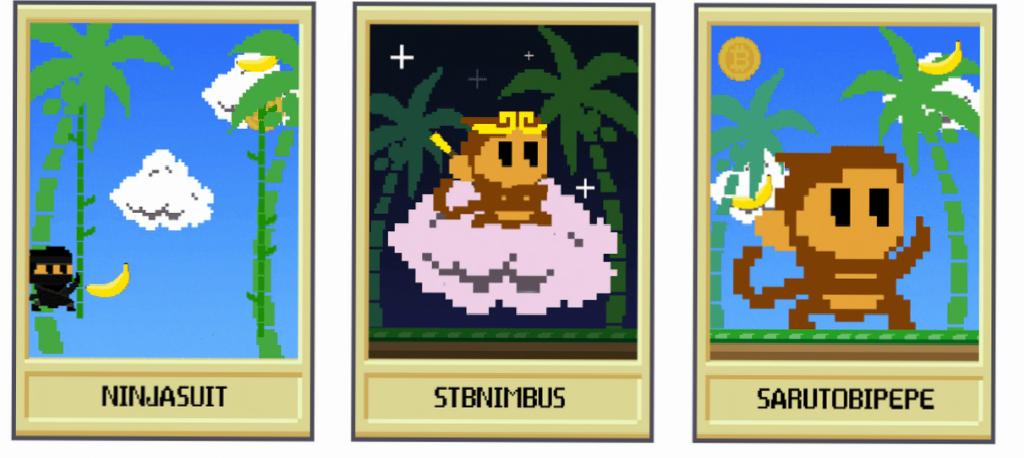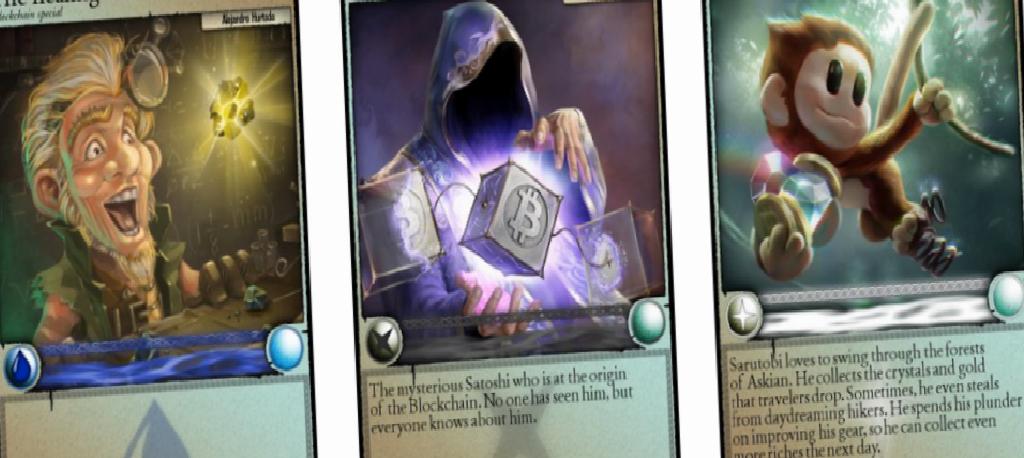NFT archeology is a new form of study in which individuals seek to uncover NFT projects that laid the foundations of modern culture. This work is essential, as all modern NFTs are built on the foundation formed by these early ruins. However, while the start date is important, what really matters is whether a project innovates and how far it takes the ecosystem. This article has been prepared by examining hundreds of projects. As technopixel.org, we share 10 Historical NFT projects that everyone should know.
10- Collections favorite NFT project “Curio Cards” (9 May 2017)
Curio Cards is a fan favorite among historic NFT collectors and is one of the oldest pieces of crypto art on Ethereum . It is about a month older than CryptoPunks. Just as Rare Pepes and Spells of Genesis are iconic collectible card projects in Bitcoin, Curio Cards is the same for Ethereum. There are a total of 30 different cards created by 7 different artists. Only some of the most distinguished collectors were able to create a complete set.

Some NFT lovers may argue whether Curio Cards really belong on this list because this NFT project has not been innovative from a technical point of view. However, with this information, we can dispel the myth that CryptoPunks was the first NFT in the ecosystem.
9- One of the important steps on the way to smart contracts: ”Pixel Map” (November 17, 2016 – Ethereum )
Inspired by The Million Dollar Homepage in 2005, Ken Erwin is the author of the artwork’s created a decentralized version of it and deployed it to the Ethereum blockchain in November 2016. This project is a billboard style project where anyone can buy a piece and change the image displayed on the tile. In this way, the billboard becomes a collaborative piece of NFT art that is never completed. This illustrates the power of how a blockchain with smart contracts can be used to push the boundaries of what NFT can be.

As NFTs evolve further in the future, it will become increasingly clear that PixelMap is one of the steps on the path to complex smart contracts. Ken Erwin took things a step further by storing image data for each pixel on the chain, making PixelMap one of the first fully on-chain NFTs.
8- First NFT cats on Ethereum “MoonCats” (August 9, 2017 – Ethereum)
These 8 bit collectible cats were the first cat NFTs on Ethereum, with a total supply of 25,440 there was. Its creators were inspired by CryptoPunks, but they made an important innovation that is often overlooked. When you press a CryptoPunk, you can choose any of them you want. All 10,000 of the 25,440 were already produced off-chain, so the first collectors who found the project quickly collected the rarest ones. This was not an effective approach. Ponderware, the team behind MoonCats, has designed a new solution for printing MoonCat. When collectors clicked the button to mint, they would have no idea which cat the blockchain would give them. By assigning the characteristics of a cat on the chain, a unique cat would be produced each time, and the collector would have no idea what the piece would look like until the transaction was approved. Of course, with the billion dollar prolific art NFT market we have today, we acknowledge that this is how mints work. However, it was revolutionary when this first happened.

Interestingly, only a small number of cats were printed in 2017, so when the project was rediscovered by NFT Archaeologists in early 2021, the collection was sold out in less than 24 hours. MoonCats’ market cap has increased from $0 to $100,000,000. If anyone continues to explore the origins of on-chain generative art, their research will definitely lead them to MoonCats. Therefore, they deserve a place on this list.
One of the most complex parts of 7-NFT projects: ”Digital Zones” (29 August 2017 – Ethereum)
French avant-garde artist Yves Klein’s 1959 ”Zones of Immaterial Pictorial” Inspired by his work “Sensibility”, Canadian artist Mitchell F Chan published a total of 101 “Digital Zones of Immaterial Pictorial Sensibility” on the Ethereum blockchain in 2017. Looking at the timeline of how crypto art has evolved, it’s clear that the launch of Digital Zones was a pivotal event. On a very deep level, Mitchell understood that the real innovation in NFTs was not just connecting the blockchain to an image, but using the blockchain itself as a tool. And it proved that there is no more powerful way to show the point than to give up the image altogether.

Yes, that’s true. No JPEGs. The chips images you see above are not for the original tokens. Art has no visual component and is invisible. As if that wasn’t epic enough, Mitchell coded a ritual function into the smart contract. In his 34-page Blue Paper, he outlined the only way to truly own art. How? As this ritual your token is burned and becomes incorporated into your artistic sensibility. This appeals to many people because a commentary on property is where the worlds of art and finance intersect. Digital Zones is considered one of the most complex pieces of crypto art. This project was the first conceptual artwork on Ethereum and demonstrated that a smart contract can be used to push the boundaries of what an artist can create. They were respected by both the crypto and traditional arts communities and were sold at Sotheby’s for prices as high as $1,532,500.
6-First FFPs: “Eggs” (July 27, 2014 – Namecoin)
Namecoin was a fork of Bitcoin. It was also the only other project that Bitcoin creator Satoshi Nakamoto was working on. It was launched in 2011 to serve as a decentralized name registration service. A few years later, in 2014, people realized they could put metadata in their name as a decentralized key-value pair. Some decided to add a profile picture to their name. Thus, the first PFPs were born.

277 of the registered PFPs were Twitter avatars known as Twitter Eggs. Collectors have described them as some of the earliest on-chain collectible NFTs and PFPs.
5-This NFT project has achieved many firsts: ”SaruTobi’ (May 6, 2016 – Bitcoin)
On December 19, 2014, a young iOS developer named Christian Moss opened the App Store. He also published a game called SaruTobi. In the game, you touch the screen to spin a monkey to see how far you can take it to fly. Christian wanted to allow SaruTobi players to purchase in-game items with Bitcoin. However, Apple did not allow this. Instead, it allowed players to collect small amounts of Bitcoin while playing. That’s how one of the first play-to-earn games was born. A few years later, Christian heard about what EverdreamSoft was doing with their tokenized gaming assets in Spells of Genesis and decided to do the same by launching NINJASUIT for SaruTobi. Thus, the project was the first example of using NFT in play and win game.

But the story doesn’t end there. Christian realized that he could lure Spells of Genesis users into his game by offering the use of game elements. Mobile wallets could connect to SaruTobi and SaruTobi could read which tokens were in their wallets. Based on token inventories, it could grant access to various features in the game. In June 2016, Christian implemented this functionality by making Spells of Genesis SATOSHICARD, SARUTOBICARD and CNPCARD playable in Sarutobi. This was the first instance of an NFT becoming interoperable between two independent games. Used together on SaruTobi, Spells of Genesis has revolutionized the multi-trillion dollar gaming and social media industries. From the ashes of its predecessor Web 1.0, the metaverse was born.
4- Origin of blockchain games: ”Spells of Genesis” (March 11, 2015 – Bitcoin)
Spells of Genesis is a blockchain trading card game built on Bitcoin. Each card contains a piece of art that represents a historic moment in blockchain history. When EverdreamSoft, the makers of Spells of Genesis, launched the FDCARD, it became the first tokenized gaming asset.

This marked the beginning of a rising tide that would eventually lead to players starting to draw strength from the central governing bodies to which they were still in many ways dependent. This moment matters a lot, as this project ushered in a new era of gaming where players have real ownership of their digital assets. When you trace the origins of blockchain games, all roads lead to Spells of Genesis.
3-Standard-setting NFT project: ”CryptoKitties” (23 November 2017 – Ethereum)
Breeding these cute little cats became so popular in 2017 that they cost gas prices very high. they literally “broken” Ethereum by raising it high. This was the first example of a blockchain game that went viral, and thus the term “NFT” was coined. CryptoKitties was also the first ERC-721 token. ERC-721 is an open standard that describes how to create NFTs on EVM-compliant blockchains, and most NFTs still use these standards today.

There is a common misconception that these cats make a poor store of value due to their unlimited supply, but this is not true. There will only be 100 founding cats and 50,000 Gen-0 cats, and there are many other niches for the hardcore collector to explore. Quite a few OGs started NFTs through CryptoKitties, including the founders of Pranksy, Chris Dixon, Nate Alex, and Axie Infinity. If you talk to any of the individuals who grew up at the time, they probably won’t hesitate to tell you about their emotional attachment to these kitties.
2-A homage to Satoshi Nakamoto: “Rare Pepes” (September 9, 2016 – Bitcoin)
No historical NFT list would be complete without Rare Pepes. These collectible cards are a core part of internet culture and are one of the first art experiments on blockchains.

Rare Pepes helped spawn the early crypto art movement. Among the nearly 1,800 cards issued in 36 series, Series 1, Card 1, which pays homage to Satoshi Nakamoto, who created Bitcoin, are the most outstanding. It’s called a Nakamoto Card, and holding one (there are only 300 total) is the only way to get into the 300 Club.
1-The most iconic NFTs in the world: ”CryptoPunks” (23 June 2017 – Ethereum)
For active members of the NFT community, it is not surprising that CryptoPunks takes the number one seat on this list. Two Canadian software developers, Matt Hall and John Watkinson, spearheaded the 10k PFP trend that has recently taken over Twitter.

These avatars are viewed as both art and collectibles, and gradually they became the world’s most iconic NFT project. Some of the rarest aliens, of which there are only nine, were priced at more than $11 million at auction.